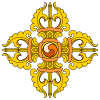Yuthok Nyingthig
Yuthok Nyingthig (Wylie transliteration: g.yu thog snying thig) is a tantric cycle composed (or re-discovered) by Yuthok Yontan Gonpo the Younger. It is a system of Buddhist practice which combines Traditional Tibetan medicine and Vajrayāna practices. These are the primary Vajrayāna practices of Tibetan medicine practitioners.
| Part of a series on |
| Vajrayana Buddhism |
|---|
 |
|
Traditions Historical traditions:
New branches:
|
|
History |
|
Pursuit |
|
Practices
Fourfold division: Twofold division: Thought forms and visualisation: Yoga:
|
|
Festivals |
|
Tantric texts |
|
Ordination and transmission |
The Yuthok Nyingthig cycle of texts contains practices such as Yuthok Nyingthig Guru Accomplishment: Compassionate Sunlight for Dispersing Suffering's Darkness (Yuthok Nyingthig Ladrub Dugngel Munpa Selwey Nyimey Oser; g.yu thog snying thig bla sgrub sdug bsngal mun pa sel ba'i nyi ma'i 'od zer).
Description of the text and practices
The practices are a part of a ngakpa (sngags pa) family lineage, and were handed down through the Yuthok family until they were taught to Sumtön Yeshe Zung (sum ston ye shes gzungs), the heart disciple of Yuthok Yontan Gonpo the Younger.[1] More recent lineage holders include the late Khenpo Truro Tsenam, the late Khenpo Tsultrim Gyaltsen, and Micho Khedrub Gyatso Rinpoche. Dr. Nida Chenagstang (lce nag tshang nyi zla he ru ka), Micho Khedrub Gyatso Rinpoche, and Gyetrul Jigme Rinpoche have taught or are continuing to teach this lineage as well.[2][3][4]
The Yuthok Nyingthig is a complete Vajrayāna cycle, including ngöndro, generation stage (bskyed rim) practices including four forms of Yuthok guru yoga and practices of Deva (i.e., yi dam) and Ḍākinī (mkha' 'gro ma), and completion stage (rdzogs rim) practices including the Six Yogas and Dzogchen.
The cycle includes additional practices such as mendrub (sman sgrub) or rituals for empowering and blessing medicine, healing and protection mantras, several pūjās, long-life practices, Medical Protectors including Shanglön (zhang blon), and instructions on a form of pulse diagnosis.[5] Lastly, there are fifteen topics addressing diagnosis and treatment within Traditional Tibetan Medicine.[1]
These practices have been of interest to academics studying the evolution of Tibetan medicine and mindfulness-based practices.[5] A translation project by the National University of Natural Medicine and the Sorig Institute seeks to translate the work from Tibetan into English.[6]
References
- Mirror of Beryl: A Historical Introduction to Tibetan Medicine Desi Sangye Gyatso, translated by Gavin Kilty, Wisdom Publications 2009. ISBN 0-86171-467-9
- Chenagtsang, Nida (2011) The Tibetan Art of Good Karma: The Hidden Treasure of the Turquoise Way Sorig Publications Australia ISBN 978-0-9808232-2-6
- "Yuthok Nyingthig Practice". Wingchunkuen. Retrieved 2014-05-18.
- "Padma Link UK News". Ripa International. 2013. Retrieved 2014-05-18.
- Garrett, F. (2007) Buddhism and the Historicizing of Medicine in Thirteenth Century Tibet. Asian Medicine: Tradition and Modernity 2(2), 204-222.
- "The Sorig Institute". Archived from the original on 2012-08-23. Retrieved 2018-11-16.
External links
- The Yukthok Nyingthig, A Perfect Journey to the Rainbow Body
- "Yuthok Nyingthig Ngondro PracticeBook (Tib. gYu Thog sNying Thig gi sNgon 'Gro)". International Academy for Traditional Tibetan Medicine. Retrieved 2014-05-18.
- "Yuthok Nyingthig Short Practice of Medicine Protector Shanglon Booklet". Tanadugshop - for traditional Tibetan medicine. Retrieved 2014-05-18.
- "Yukthok Nyingthig". ATTM - Akademie für Traditionelle Tibetische Medizin. Retrieved 2014-05-18.